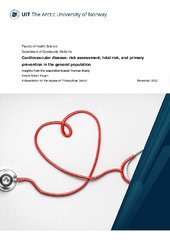| dc.contributor.advisor | Hopstock, Laila Arnesdatter | |
| dc.contributor.author | Hagen, Amalie Nilsen | |
| dc.date.accessioned | 2023-02-03T15:34:54Z | |
| dc.date.available | 2023-02-03T15:34:54Z | |
| dc.date.issued | 2023-02-20 | |
| dc.description.abstract | Cardiovascular disease (CVD) is a major cause of mortality and morbidity, calling for an active preventive approach. Elevated blood pressure and cholesterol, smoking, diabetes, unhealthy diet, inactivity, and obesity are key risk factors for CVD development. Several risk factors combined may put an individual at a high total CVD risk. To measure total CVD risk, we used the NORRISK 2 score that estimates the 10-year risk of fatal and non-fatal myocardial infarction and stroke. This thesis used data from the population-based Tromsø Study, Tromsø6 (2007-2008), and Tromsø7 (2015-2016) to study total CVD risk and primary prevention in the general population. We observed a decline in total CVD risk during the time period and a change in the distribution from higher to lower risk categories. The NORRISK 2 score and the current primary prevention guidelines increase the population proportion at risk by 3.4 percentage points compared to the former risk score and guideline. Individuals with a high risk of CVD experienced several favourable changes in CVD risk factors between Tromsø6 and Tromsø7. However, less than 1 in 10 achieved all blood pressure, lipids, and smoking treatment targets combined. Individuals with the highest risk of CVD have the lowest probability of achieving treatment targets. Our results showed that medication use was the most important factor associated with target achievement. We have demonstrated a potential for improvement in the primary prevention of CVD, and more attention and closer follow-up of high-risk individuals are needed. | en_US |
| dc.description.doctoraltype | ph.d. | en_US |
| dc.description.popularabstract | Cardiovascular disease (CVD) is a common reason for illness and death. Elevated blood pressure and cholesterol, smoking, diabetes, unhealthy diet, inactivity, and obesity are known risk factors. Several risk factors combined can put an individual at high total risk for CVD. The NORRISK 2 score calculates the 10-year risk of an acute heart attack, stroke, or death due to CVD. We used data from the population-based Tromsø Study; Tromsø6 (2007-2008) and Tromsø7 (2015-2016). Our results showed that total CVD risk declined in the time period. Less individuals were identified as having high total risk of CVD. More individuals were defined as having a high total risk of CVD using NORRISK 2 and the current guidelines compared to the former risk score and guidelines. Less than 1 in 10 high risk individuals reached treatment targets. Medication use was the most important factor associated with target achievement. More attention and closer follow-up of high-risk individuals is needed. | en_US |
| dc.description.sponsorship | Helse Nord | en_US |
| dc.identifier.uri | https://hdl.handle.net/10037/28493 | |
| dc.language.iso | eng | en_US |
| dc.publisher | UiT The Arctic University of Norway | en_US |
| dc.publisher | UiT Norges arktiske universitet | en_US |
| dc.relation.haspart | <p>Paper I: Nilsen, A., Hansen, T.A., Lappegård, K.T., Eggen, A.E., Løchen, M.L., Njølstad, I., Wilsgaard, T. & Hopstock, L.A. (2019). Secular and longitudinal trends in cardiovascular risk in a general population using a national risk model: The Tromsø Study. <i>European Journal of Preventive Cardiology, 26</i>(17), 1852-1861. Also available at <a href=https://doi.org/10.1177/2047487319830806>https://doi.org/10.1177/2047487319830806</a>.
<p>Paper II: Nilsen, A., Hansen, T.A., Lappegård, K.T., Eggen, A.E., Løchen, M.L., Selmer, R.M., Njølstad, I., Wilsgaard, T. & Hopstock, L.A. (2021). Change in cardiovascular risk assessment tool and updated Norwegian guidelines for cardiovascular disease in primary prevention increase the population proportion at risk: The Tromsø Study 2015-2016. <i>OpenHeart, 8</i>(2), e001777. Also available in Munin at <a href=https://hdl.handle.net/10037/23175>https://hdl.handle.net/10037/23175</a>.
<p>Paper III: Hagen, A.N., Ariansen, I., Hanssen, T.A., Lappegård, K.T., Eggen, A.E., Løchen, M.L., Njølstad, I., Wilsgaard, T. & Hopstock, L.A. (2022). Achievements of primary prevention targets in individuals with high risk of cardiovascular disease. An 8-year follow-up of the Tromsø Study. <i>European Heart Journal Open, 2</i>(5), oeac061. Also available in Munin at <a href=https://hdl.handle.net/10037/28414>https://hdl.handle.net/10037/28414</a>. | en_US |
| dc.rights.accessRights | openAccess | en_US |
| dc.rights.holder | Copyright 2023 The Author(s) | |
| dc.rights.uri | https://creativecommons.org/licenses/by-nc-sa/4.0 | en_US |
| dc.rights | Attribution-NonCommercial-ShareAlike 4.0 International (CC BY-NC-SA 4.0) | en_US |
| dc.subject | VDP::Medisinske Fag: 700::Helsefag: 800::Samfunnsmedisin, sosialmedisin: 801 | en_US |
| dc.subject | VDP::Medical disciplines: 700::Health sciences: 800::Community medicine, Social medicine: 801 | en_US |
| dc.subject | VDP::Medisinske Fag: 700::Helsefag: 800::Forebyggende medisin: 804 | en_US |
| dc.subject | VDP::Medical disciplines: 700::Health sciences: 800::Preventive medicine: 804 | en_US |
| dc.subject | Tromsøundersøkelsen | en_US |
| dc.subject | The Tromsø Study | en_US |
| dc.title | Cardiovascular disease: risk assessment, total risk, and primary prevention in the general population. Insights from the Tromsø Study | en_US |
| dc.type | Doctoral thesis | en_US |
| dc.type | Doktorgradsavhandling | en_US |


 English
English norsk
norsk
